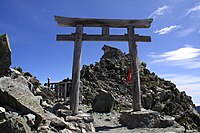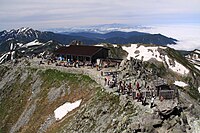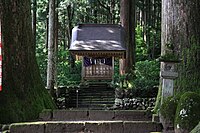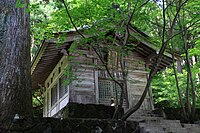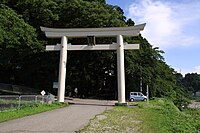| Oyama Shrine | |
|---|---|
 | |
| Religion | |
| Affiliation | Shinto |
| Deity |
Ame-no-Tajikarao,
Izanagi, Amitābha (formerly) |
| Location | |
| Geographic coordinates | |
Oyama Shrine (雄山神社) is a Shinto shrine located in Japan that worships Mount Tate. The shrine is located at a high altitude of 3,003 meters and has three sub-shrines. [1]: 97 Several million people visit the shrine every yearr. [2]
It is located on Oyama peak, one of the three peaks of Mount Tate. [3]
It used to be called Tateyama Gongen, but was renamed Oyama Shrine in 1869 during Haibutsu kishaku. [4]
Oyama Shrine has a rich history and was historically a major site of Shugendō, a Japanese religion that combines elements of Buddhism, Shintoism, and other indigenous beliefs.. [5]: 141–143 [6]: 55
The shrine claims to be the Ichinomiya (highest ranked Shinto shrine) of Etchū Province, but there are other shrines that also claim this title.
Oyama Shrine is unique in that it does not have a honden, which is a main hall for enshrining the kami (deities), instead, Mount Tate itself is considered its main object of worship, known as the kannabi.
This is a rare practice and the only major shrines that continue the practice of direct Mountain Worship via Kannabi are Ōmiwa Shrine and Suwa-taisha and Kanasana Shrine. [7] [8]
History
Early History
The mountain's history goes back to the year 701. At that time, Saeki-no-Ariwaka's son, Ariyori, saw a vision of the Three Buddhas there. He then set up the Tateyama Daigongen Shrine. [5]: 141–143
Recognition
In 863, Emperor Seiwa recognized the mountain's god. This event is in the ' Nihon Sandai Jitsuroku'. [5]: 141–143
It is recorded in the Engishiki Jinmyocho as a Shikinai Shosha.
Literary References
Tateyama appears in old texts. It is sometimes mixed up with another mountain, Tsurugi. The mountain's deity is mentioned in these texts. [5]: 141–143
Shugendo
Before the Meiji era, the mountain was a major Shugendō pilgrimage site. [5]: 141–143
The Tateyama cult is related to Mount Tateyama in Toyama Prefecture, Japan. This mountain is important in Shugendo. Tateyama has three peaks. Each peak is around 3,000 meters high. The cult started with mountain worship. It combines different beliefs. Oyama Shrine is at the mountain's summit. This shrine honors Shinto gods. It is also linked to a Buddhist paradise and hell. [6]: 55 The cult is sometimes linked to the Kumano cult. [9]: 220
Mount Tateyama is seen as a home to kami and the underworld. Buddhism influenced this view. Buddhist ideas of paradise and hell are found here. Many landmarks in Tateyama have names from Buddhism. For example, Mount Jodo is named after Amitābha Buddha's paradise. Dainichi Peak represents a major Buddhist figure. Lake Suzuri symbolizes a heavenly place in Buddhism... [9]: 167–173
Buddhist and Shinto beliefs merged in Tateyama. A shrine on the mountain links Izanagi to Amitābha Buddha. Another peak connects Ame-no-Tajikarao a god of strength to the Buddhist god Acala (Fudo Myoo)... [9]: 167–173
Jigoku-dani (Hell Valley) is a place in Tateyama. It looks like a hell with boiling water and fire. People believed spirits of the dead were here. A Buddhist story talks about a condemned woman in this hell. Her sons tried to find her with a monk's help... [9]: 167–173
Japanese beliefs connect paradise and hell to our world. Buddhism teaches about good and bad actions. Good actions lead to a pure land. Bad actions lead to suffering in hell. Shamans tried to save people suffering in hell.. [9]: 167–173
Buddhist ascetics were important in Tateyama. They belonged to a special Buddhist group. They trained in the mountains. They learned healing and other powers.. [9]: 167–173
Tateyama attracted these priests. They believed valleys were mystical. They thought spirits protected their descendants from mountains.. [9]: 167–173
Two communities, Iwakuraji and Ashikuraji, were the main centers of this cult. [10]: 137
Iwakuraji was the predecessor to Maedate-shadan and Ashikuraji was the predecessor to Chuuguu-kiganden. [10]: 137
They both worshipped Tateyama Gongen. But they also competed for control over the mountains. Iwakuraji was at the mountain's base. This community guided pilgrims to Oyama Jinja Mine Honsha. They also worshipped Tachio Tenjin. Ashikuraji was up the foothills. They worshipped Ubason. They lost control battles to Iwakuraji. So, they focused on collecting contributions in cities. They also held rituals for those who couldn't climb the mountain. [10]: 137
Oyama Shrine is important in Tateyama. Two communities, Ashikuraji and Iwakuraji, were key. They practiced Buddhism and Shinto. They held services at Oyama Shrine. This shrine was recognized in old Japanese records.. [9]: 167–173
In the 14th and 15th centuries, these communities were involved in politics. They also became known as healers. They helped with illnesses and other needs.. [9]: 167–173
The communities relied on donations. They competed for the right to collect donations. In 1833, they agreed on their donation areas.. [9]: 167–173
Missionaries from Ashikuraji traveled across Japan. They carried paintings. They promoted Tateyama mountain worship. They also held special rituals... [9]: 167–173
The Tateyama Mandala is a collection of paintings. They show stories and scenes from Tateyama. They are from the 17th century. The paintings vary in style. Some focus on stories. Others show landscapes or hell scenes. Owners paid for these paintings themselves.. [9]: 167–173
Both communities were under the Kaga domain. They were different from other Shugen groups. They prayed for the domain's well-being. They organized events in their communities. [10]: 137
Tateyama Gongen is linked to Amitabha and Izanagi. Amitabha is a Buddhist figure. Izanagi is a Shinto kami. The worship of Tateyama Gongen may have started by the twelfth century. [10]: 137
The Tateyama cult became popular during the Edo period. This period was between the seventeenth and mid-nineteenth centuries. Both religious practitioners and ordinary people followed the cult. They came from all over Japan. They formed pilgrimage groups called Tateyama ko–. These groups visited the mountain from different regions. Villages grew along the pilgrimage route. They provided lodgings for the pilgrims. [6]: 55
At the base of Mount Tateyama, there are sacred sites. One of these is Nissekiji Temple in the Oiwa district. Sick people went there for healing. The temple was founded in 725. Buddhist monk Gyoki started it. He carved an image of Fudo Myo O, a Buddhist deity. This carving became significant in Shugendo. The temple was fully built by the mid-seventeenth century. Around 1700, people believed the temple's waterfalls could cure eye diseases. They also thought the waterfalls helped with mental illnesses. [6]: 55
Meiji Period
In the Meiji period, the worship sites on Mount Oyama changed. This was part of separating Buddhism from Shinto. The shrine at the peak became Oyama Jinja's inner shrine. It was named Mine Honsha. The former Iwakuraji and Ashikuraji became Maedachi Shaden and Kiganden. [10]: 137
The Kaga lord split Iwakuraji and Ashikuraji. This was to prevent them from becoming too powerful. [10]: 137
The shrine used to be called Tateyama Gongen, but was forcibly renamed Oyama Shrine in 1869 during Haibutsu kishaku by Kaga Domain authorities. [4]
Modern Changes
Tateyama is now a tourist spot. It has a cable car and new roads. Plans include a tunnel for tourists. It has changed from a pilgrimage site to a tourist place. [5]: 141–143
Mountain sites
Mountain Appearance
Tateyama looks like a continuous crest from a distance. Its peak is not clear. From Toyama, it is mostly hidden. [5]: 141–143 The path to the top has many stories and monuments. [5]: 141–143
Log Basalt
There is basalt called Zaimoku-saka that looks like logs. According to legend a nun brought logs there for building Nyoindō and they were petrified. [5]: 141–143
Mirror Stone
The Mirror Stone is a highly reflective flat rock. It is about three yards wide. There is a legend about this stone. It involves Ariyori. Ariyori made the mountain accessible to pilgrims. His nurse followed him to this place. She could not go any further. She threw her mirror in desperation. The mirror turned into the Mirror Stone. There is another boulder nearby. It is known as the Old Woman Stone.. [5]: 141–143
Jigoku-dani
This valley has steaming vents. It was seen as a hell-like place. It is in old tales and a Noh play. [5]: 141–143
Jigoku-dani (Hell Valley) is a place in Tateyama. It looks like a hell with boiling water and fire. People believed spirits of the dead were here. A Buddhist story talks about a condemned woman in this hell. Her sons tried to find her with a monk's help... [9]: 167–173
It not to be confused with the more famous Jigokudani Monkey Park where monkeys sit in hot springs. [11]
Mikuri-ga-ike
This lake is known for its blue waters. A monk's story is linked to it. [5]: 141–143
People told the monk not to swim in the pool. But he refused to take their warnings and swam anyways. [5]: 141–143
The first time he swam, he had a dagger in his mouth. He came out safely. The second time, he swam without the dagger. He swam around once, then twice. On his third round, he was pulled under the water. He never came back up. This event named the lake "Thrice Round Pond." The name comes from his three swims in the lake.. [5]: 141–143
Murodō
This is Japan's oldest mountain lodge. It was built in 1695. [5]: 141–143
Architecture
Oyama Shrine has three parts. [1]: 97 Similar to Chōkaisan Ōmonoimi Shrine. [12] The first part is the front altar. It is easy to reach. The second part is the prayer hall. It is at Ashikuraji, upriver from the altar. The third part is the main shrine. It is on the top of Mount Tateyama. The shrine is hard to reach. It is often covered in snow for half of the year. [1]: 97
Chugu Kiganden sometimes calls its shrine Gegu in reference to the Geku of Ise Grand Shrine. [9]: 220
All three parts make up the Oyama Shrine. When the top is snowed in, people pray at the first two parts. These are nearer to the town. In the Edo Period, the area was busy with pilgrims. They often started their climb at the front altar. There were twenty-four lodges there for them. Ashikuraji had thirty-three lodges. [1]: 97
Rituals
Cloth Bridge Rite
The Cloth Bridge rite is a very major rite of the Tateyama cult. [4]: 75–79
Ritual Exchange of Robes
The meshikae is a yearly ritual on March 13th. It involves changing robes for Uba statues. It used to be for older women only. Now, more people can join. The robes are made by hand in a traditional way. They are brought to the Oyama Jinja shrine. There, they go through a procession and a cleaning ceremony.. [4]: 75–79
Yama no Kami Ritual
Another festival is for the yama no kami, the god of Mount Tate. It takes place at the Shinpi Jinja. Local men and forestry workers gather for blessings. [4]: 75–79
Gallery
Mine-honsha Shrine
-
Mount Tateyama
The shrine is visible at the top right -
Main shrine
-
Birds eye view of the shrine
-
Shrine office
-
Survey point
Chuuguu-kiganden
-
Shrine grounds
-
Honden
-
Festival hall
Maedate-shadan
-
Shinmon
-
Main Hall
See also
- List of Shinto shrines
- The other three major mountains
- Fuji - Fujisan Hongū Sengen Taisha
- Haku - Shirayama Hime Shrine
- Other shrines claiming to be Etchū Ichinomiya
References
- ^ a b c d Bandō, Masako (2013-02-01). Mandala Road. Anthem Press. ISBN 978-0-85728-267-5.
- ^ Louis-Frédéric (2002). Japan Encyclopedia. Harvard University Press. ISBN 978-0-674-01753-5.
- ^ Fay, Tom; Lang, Wes (2019-03-27). Hiking and Trekking in the Japan Alps and Mount Fuji: Northern, Central and Southern Alps. Cicerone Press Limited. ISBN 978-1-78362-714-1.
- ^ a b c d e Malá, Zuzana (2019-01-01). Religious practices in the Japanese mountains: From fleeing the hells towards the healthy, sustainable and spiritual practices of the consumer society. Masarykova univerzita. ISBN 978-80-210-9198-6.
- ^ a b c d e f g h i j k l m n o Fukada, Kyūya (2014-12-31). One Hundred Mountains of Japan. University of Hawaii Press. ISBN 978-0-8248-4785-2.
- ^ a b c d Harding, Christopher; Fumiaki, Iwata; Shin’ichi, Yoshinaga (2014-09-15). Religion and Psychotherapy in Modern Japan. Routledge. ISBN 978-1-317-68300-1.
- ^ Cali, Joseph; Dougill, John (2012). Shinto Shrines: A Guide to the Sacred Sites of Japan's Ancient Religion. Honolulu: University of Hawai'i Press. p. 195. ISBN 978-0-8248-3775-4.
- ^ "Keeping Ancient Mountain Worship Alive at Saitama's Kanasana Shrine". nippon.com. 2018-07-08. Retrieved 2023-10-18.
- ^ a b c d e f g h i j k l m n Kaminishi, Ikumi (2006-01-01). Explaining Pictures: Buddhist Propaganda And Etoki Storytelling in Japan. University of Hawaii Press. ISBN 978-0-8248-2697-0.
- ^ a b c d e f g Saka, Chihiro (2022-07-18). Datsueba the Clothes Snatcher: The Evolution of a Japanese Folk Deity from Hell Figure to Popular Savior. BRILL. ISBN 978-90-04-51767-7.
- ^ Scheffel, Richard L.; Wernet, Susan J., eds. (1980). Natural Wonders of the World. United States of America: Reader's Digest Association, Inc. pp. 193. ISBN 0-89577-087-3.
-
^
"chokaizan omonoimi shrine(warabioka kuchi no miya) - shrine-heritager". shrineheritager.com. Archived from the original on 2023-11-11. Retrieved 2023-04-25.
{{ cite web}}: CS1 maint: unfit URL ( link)


